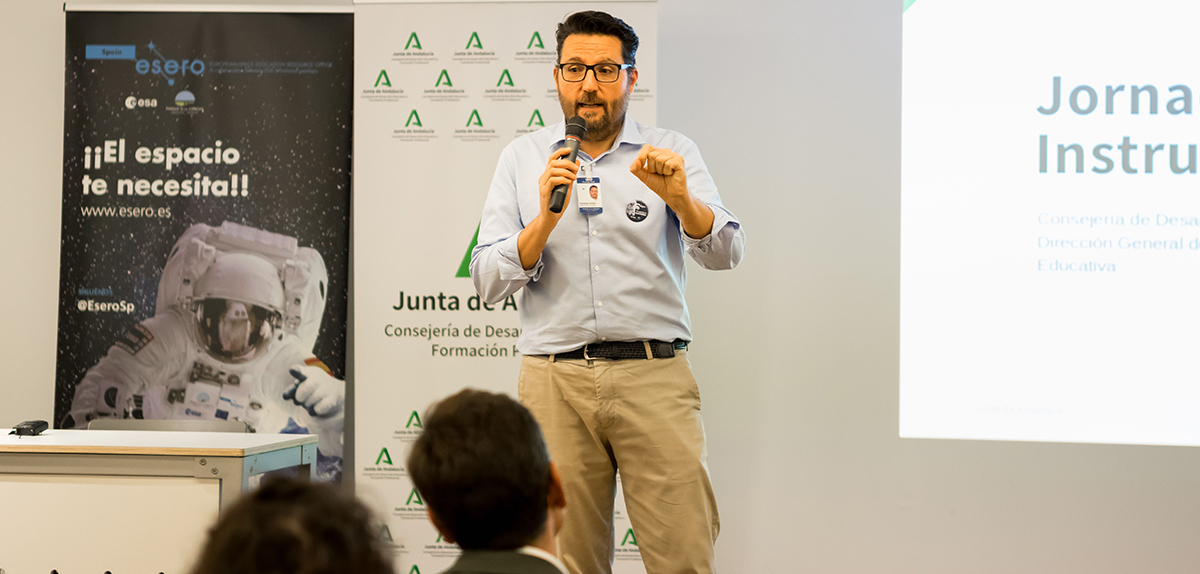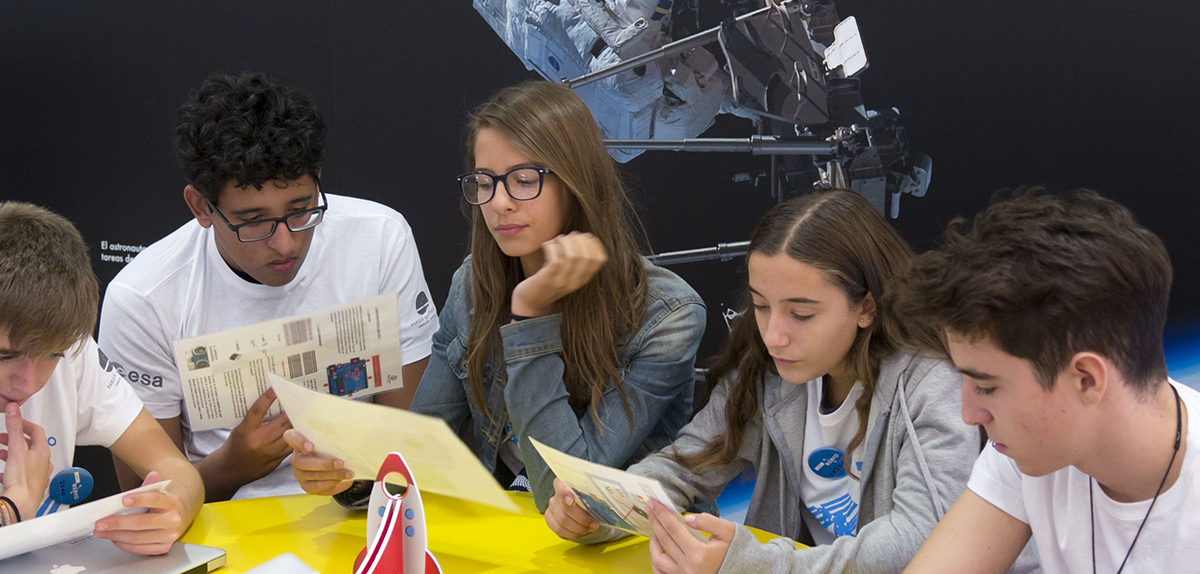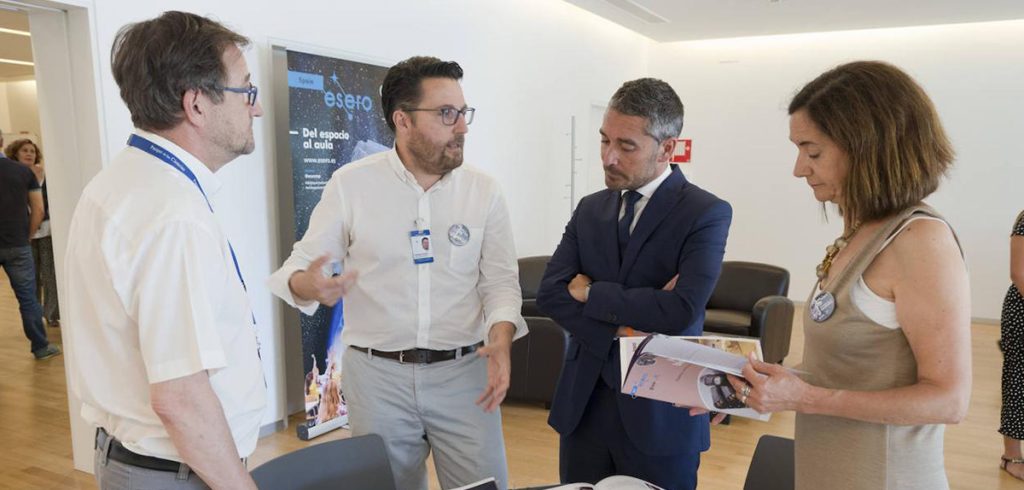His training and his professional career related to management, science and training have led him to be a specialist in the execution of infrastructures and the design of scientific dissemination activities.
In 1998 he embarked on the start-up of the Príncipe Felipe Science Museum where he rotated through different areas until he reached the position of Director of Contents of the City of Arts and Sciences of Valencia, revitalizing its spaces and programming activities for more than 3 million visitors per year.
More recently, Domingo has been a consultant in different ministerial initiatives to promote science at international level (Operational Program for Research and Development for Innovation, Ministry of Education, Youth and Sports - Czech Republic.
Higher Education Teaching Infrastructure Program - Republic of Serbia.
In 2017 he joins the team of Parque de las Ciencias de Granada as ESERO Manager coordinating at national level the Educational Resources Office ESERO Spain, a project of the European Space Agency for the promotion of Science and Technology Education in Spain.
When did you start leading ESA’s ESERO Project in Spain, and what were your motivations for taking on this important challenge?
A unique project, with an accentuated public service, inclusive, educational, all to be developed, national and international scope, high impact on teachers and students, with ESA and the Science Park as main collaborators.
I left Valencia and settled in Granada. Provisionally I have been there for six years and with the current renewal of my contract with ESA, at least three more years of activity await me. A personal and professional challenge.
Neither the nature nor the development of professional skills in any sector is divided by separate subjects or plots. Everything is interconnected and an interdisciplinary approach is needed to address any problem.
Educational systems are trying to adapt and the use of STEAM methodology is part of the need to improve the training of students and teachers.
In such a changing world and with so much dependence on technology, it is necessary to encourage scientific-technological vocations from an early age. This methodology is key to achieving this.
In particular, from ESERO, if we had to highlight the most relevant issues of the influence of STEAM training from childhood, in terms of the present and future contribution to the development of the space sector, which ones would you highlight?
Future generations are going to face challenges and challenges that we do not know about, new technologies will be developed and jobs will be created that have not been needed before and in environments that are very different from the ones we know.
So, it must be understood that the space sector is not just the future. Although a space mission may take 20 years to see the light of day, it is an activity with a high influence on the present and on important aspects of our daily lives; it is a key sector for development.
Nor is it exclusive to a few. It is essential to know the different professional opportunities that are being generated.
There is an immense variety of professions, in addition to astronaut. Law, medicine, engineering, design, programming, security, artificial intelligence, mechanics, project management, finance, there is no traditional sector that has no place in the space sector.
Another important aspect is entrepreneurship. The rapid evolution of New Space is motivated in part by the entrepreneurial capacity that has been cultivated years ago.
The specific training of primary
and secondary school teachers in our country has a relevant incidence. How would you quantify the level of attunement with the space sector? What areas of impact would you highlight as the most relevant to promote and improve?
The use of space as a setting is a source of inspiration and motivation that few sectors enjoy, and it is fundamental as a tool for the teaching-learning process.
In general, it works well with almost any sector. Lately, Earth observation and climate change are leading these areas to gain popularity. Space robotics and artificial intelligence are also highly attractive and known. The search and characterization of exoplanets, rocket launch, space transportation, etc.
In general, any realm of the sector is a perfect complement to teaching activities; the key is developing specific materials and education.
If look into the near future, telecommunications (broadband communication / quantum communication), fast and precise response capabilities (satellite navigation, Earth observation) and the human exploration of Mars will be the next areas of development of the sector. So we will have to work on new materials and specific education programs.
However, on some occasions space can seem to be only accessible to an elite. Educators may feel ill-prepared. For this reason, it is very important to keep investing in training.
Once the materials and activities that we develop are known and put into practice, they have a great impact and are always highly regarded by both teachers and their students.
What activities do you think companies that make up the Spanish space industry could undertake in relation to STEAM to foster and actively contribute toward this strengthening and development of the sector?
And I don’t mean just offering money, which is always important. I am also referring to collaborating in kind, enabling sector professionals to invest hours in activities with students and educators, touring facilities, providing their own material, participating in talks, etc.
This is part of our “El Espacio entra en las aulas” (“Space joins the classroom”) initiative and it allows students to get to know young businesspersons and professionals of the sector first hand, in addition to discovering new materials and prototypes that are being developed for new space missions, which are combined with activities tailored to the curricula.
When looking back just a few years, we truly see an advancement both in the introduction of STEAM to classrooms in general, and in the knowledge and general acceptance by the public of the importance of the space sector. How do you visualize this progress in the next ten years?
In the last five years alone progress has been exponential, so we are at the gates of a true revolution.
The creation and generation of talent will be a decisive factor for our society. Aligning the sector’s industrial strategy with a long-term vision of the educational program we are implementing is the key to contribute toward the development of the capabilities required by the space sector.
As I was saying before, we will see jobs that are not yet being sought, technology that has not been invented and problems we cannot anticipate. And all of this will need to be addressed by the young people who are going through their education today.
I also see that we will have to evolve and, as ESERO, we will not just have to approach education from a regulated and homologated standpoint. We will also have to broaden our range of activities to accommodate non-formal and informal education.
Serve new audiences (child education, families, non-STEM students, professionals starting their university education). Strengthen the connection between research, innovation and education.
Promote innovation through diversity and inclusion. There are very interesting challenges ahead for everyone.
What differentiating factor of Spain would you highlight when compared to the rest of the ESA member countries, in this endeavor?
Networking, without a doubt! ESERO is a network of offices in each of the ESA member states. Networking and collaborative work is in its DNA. But in our case, I would define it as a two-tier need: institutional and educational.
Successfully collaborating with each of the Education Councils of the various Autonomous Communities to create various personalized educational innovation programs adapted to the nuances of each territory has been the key to being one of the ESEROs with the highest national impact. These programs allow educators to homologate the training that they receive and the access to materials and resources in an orderly fashion (and for free).
However, there is another factor that is just as important, and this is the performance of our ETTs (which may not be an attractive term, but it stands for ESERO Teacher Trainers).
Active educators that train other educators. ESERO is a small three-person team (Elena Álvarez, Carmen Botella and yours truly) and we do not yet have the capability to grow in order to engage in training sessions and activities in several places at a time. So we decided to implement and foster the active participation of the most-involved educators of each region.
Their assistance, their direct knowledge of the different situations in classrooms, the ability to adapt and tailor contents to each of these situations and their motivation is the true key to success. I have nothing but gratitude toward them and I am at their full disposal. We are always wide open to their suggestions, comments and proposals in order to continue improving.
How does the creation of the Spanish Space Agency affect ESERO’s activities?
The creation of the AEE is great news. In my opinion, it will strengthen the entire space sector even more. More resources and investments that will generally enable us to be more competitive as a major economic and social driver.
Specifically for our field, I am hopeful that, as part of its foundation, it will include some kind of article similar to Article V of the ESA convention, and that education will be considered a mandatory activity as part of any program and that it also will provide us with more resources.
The more streamlined sector dynamics will make companies grow, and more and better talent will be required, meaning that our activities as educators and communicators will have to expand their reach.
One of your better-known activities in ESERO is organizing the CANSAT competition in Spain. Could you tell our readers, what it is about? How many schools and youngsters are involved each year in this important initiative?
CanSat is a competition sponsored by the European Space Agency, aimed at teams of High School students. The teams must design and build a small satellite the size of a soda can.
This challenge offers a unique opportunity for students to have their first practical experience in a real space project. They have to be able to organize all of the mission’s technical aspects: designing the CanSat, choosing its mission, integrating the components, testing, preparing the launch, accomplish a safe landing and then analyzing the data.
A true technological challenge that fosters a calling for science among youngsters.
The finals of the national CanSat competition will be held in Granada in May of 2023, and it involves the launching of rockets (up to a height of 900 m) that contain the CanSat projects developed by the teams selected for the finals, the winner of which will represent the country in the European competition.
In addition, regional competitions will be held in most Autonomous Communities, which will allow for the selection of the finalist teams that will travel to take part of the national competition.
This means a participation of over 400 educators and 5,000 students in 2023.
So, as I was saying, networking and the involvement of public education administrations are the key to success.







